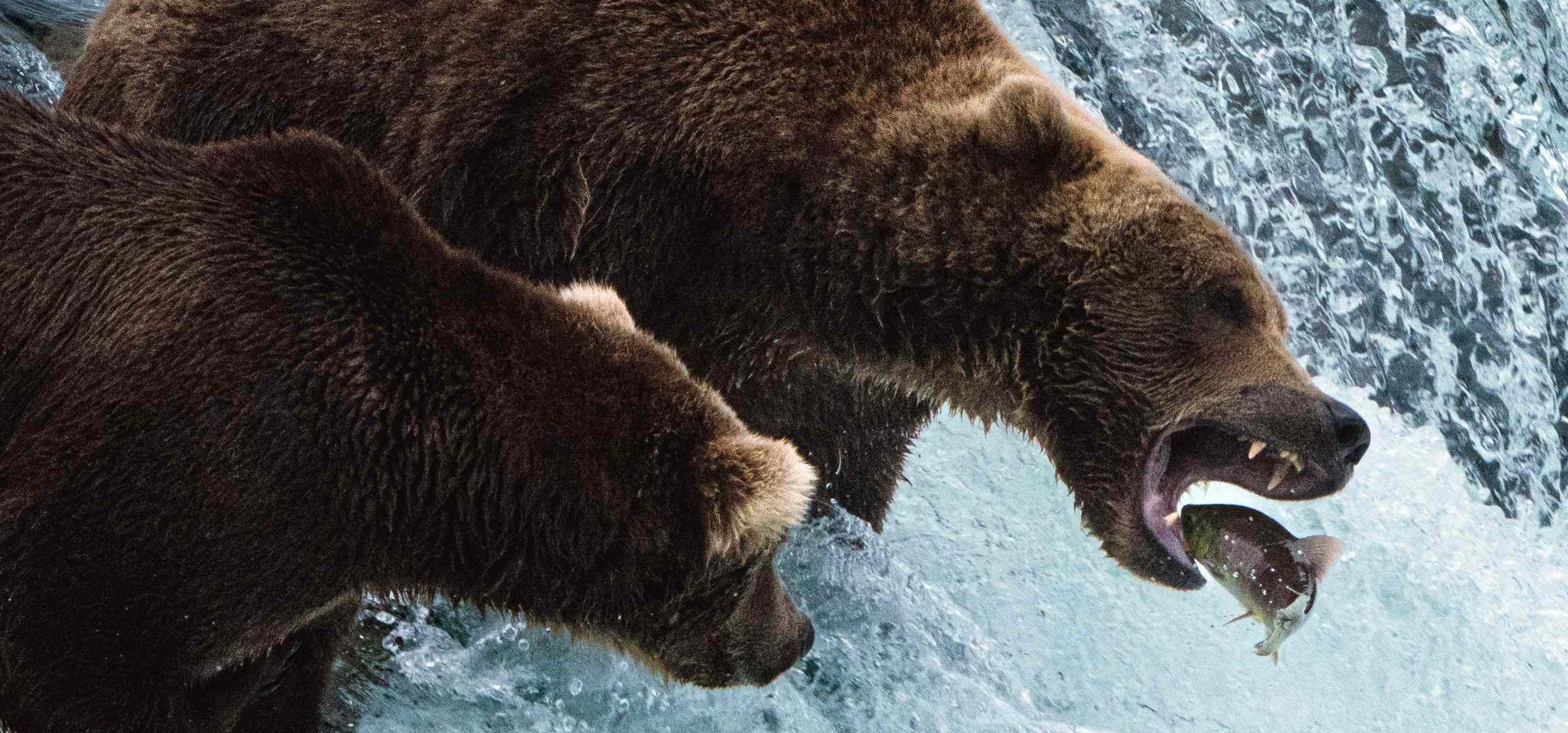Held annually, the Katmai National Park and Preserve in Alaska kicks off Fat Bear Week around the first week of October with their partner and wildlife streamer, Explore.org. The single-elimination tournament invites wildlife enthusiasts across the globe to celebrate the upcoming winter hibernation season of brown bears. Watch the parks’ live video feeds of the bears feasting on salmon to build their fat reserves, then cast your vote on which bear you believe will end up as the fattest champion.
Throughout the festivities, celebrate the strength, viciousness, and adaptability of these magnificent creatures as they fight to survive Alaska’s harshest climates. Fat Bear Week also brings crucial awareness to bear conservation and encourages greater respect for the Alaska Peninsula brown bear (Ursus arctos gyas).
What Is The History Of Fat Bear Week?
The competition began as a one-off event held by Katmai National Park and Preserve, before going viral online. Since then, Fat Bear Week has become an annual tradition with participants from all over the world.
“Fat Bear Week originated in 2014 when park ranger, Mike Fitz, created the idea after seeing the great interest people had in watching bears feeding on salmon,” explains Matt Johnson, Interpretation and Education Program Manager and Public Information Officer at Katmai National Park and Preserve. “Visitors were asked to review before and after photos and vote on the fattest bear. It began as a one-day event on Facebook called ‘Fat Bear Tuesday’.”
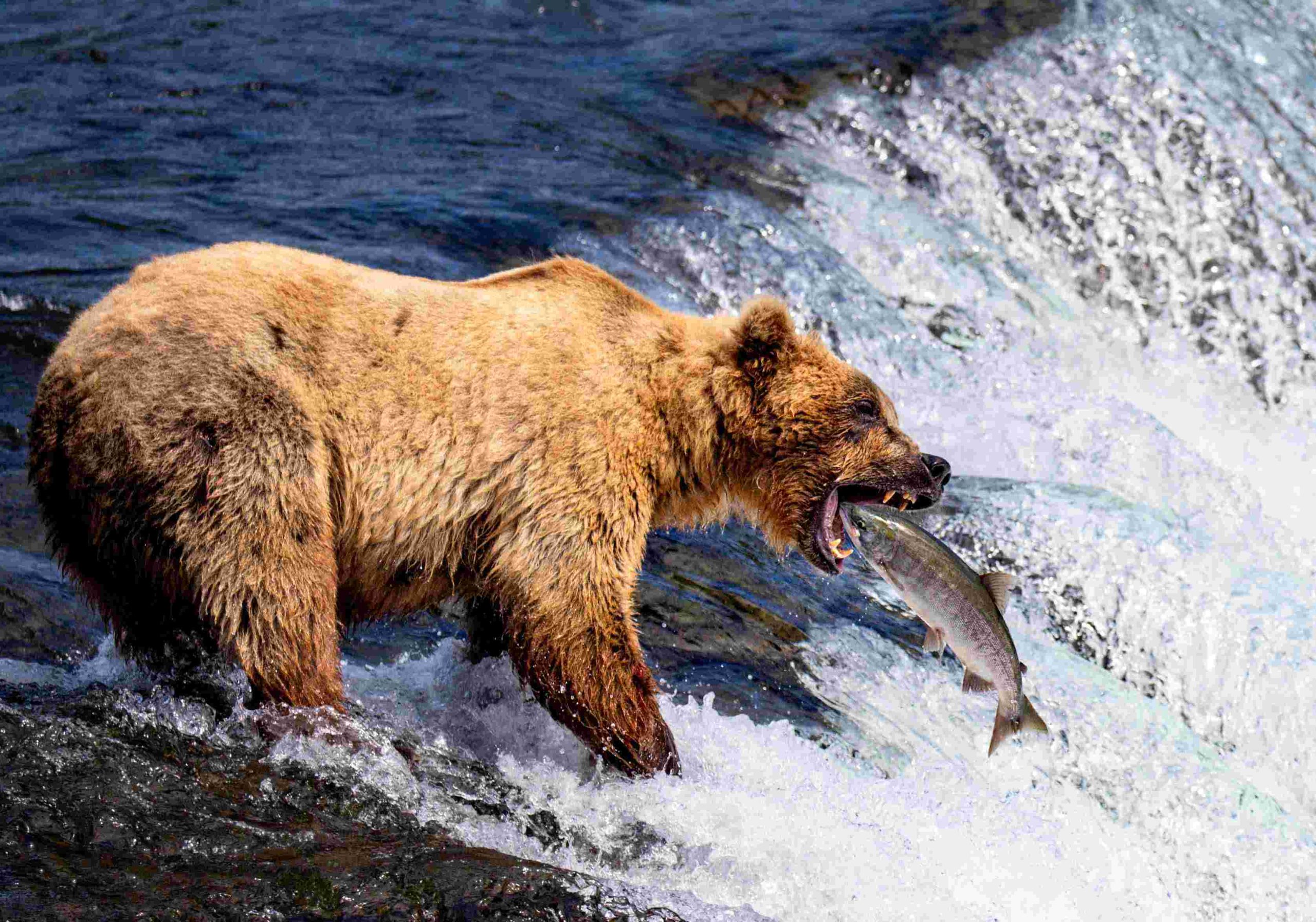
A grizzly bear catching fish at Brooks Falls in Katmai National Park and Preserve.
However, the response from the public was greater than expected and Katmai National Park and Preserve turned the competition into a week-long, web event. Matt explains, “The general response was spectacular. It went viral and it’s grown as a worldwide phenomenon.”
During Fat Bear Week, voters form sincere connections to the bears who are “big and charismatic, and each one has a different personality– from how they forage at Brooks Falls [to catch salmon], to their different appearances, and characters. We see a lot of us reflected in them as we look at bears.”
While the competition received 1,700 votes in 2014, the 2023 tournament saw a total of 1.3 million votes cast, reflecting the soaring popularity of this annual event.
Preparing For Fat Bear Week
While the bears gear up for feasting, Katmai National Parks and Preserve staff undergo extensive preparation leading up to Fat Bear Week.
Once the bears appear at Brooks River, usually during the late summer when the salmon run begins, staff must identify and photograph the bears. Staff continue to monitor and document their weight throughout the salmon-catching season so voters can compare the bears’ weights before and after feasting on fish. The process is tricky as “bears, like us, are not always in the mood to have their photo taken, show up at the river, or cooperate,” Matt shares.
Additionally, rangers must decide who will go head-to-head in the tournament brackets, which typically feature a total of 12 bears every year.
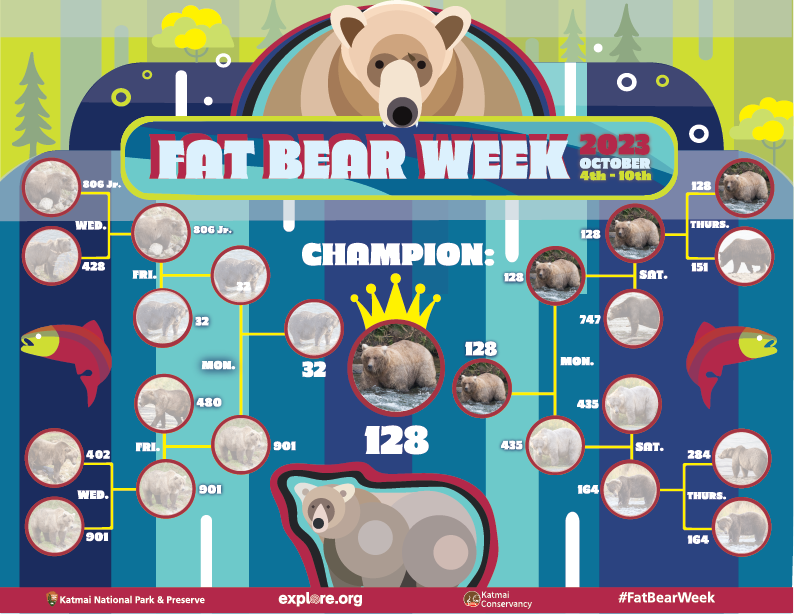
Fat Bear Week 2023 Bracket. Credit: Explore.org and NPS.
This decision which ultimately, “a judgment call. It’s based on what the photographs are, which bears are more charismatic, and which have the best story going for them. A lot of what makes the best stories are females with cubs, previous champions, ones with odd characteristics to make them stand out, new bears with a lot of charisma and energy, or old bears–like Otis.”
Otis is one of the park’s most beloved bears. While most bears live up to being 20, Otis is an older bear at 27 and is also a four-time crowned Fat Bear Week champion. He worried many people last summer when “he didn’t show up when he usually does. Mid-July is a prime time to catch a summer salmon run and the other bears were there. He’s identified by large grey streaks, damage to his left ear, and he only has two teeth. People were wondering if he survived the winter before finally showing up on July 26, spry, motivated, and hungry for salmon,” Matt says.
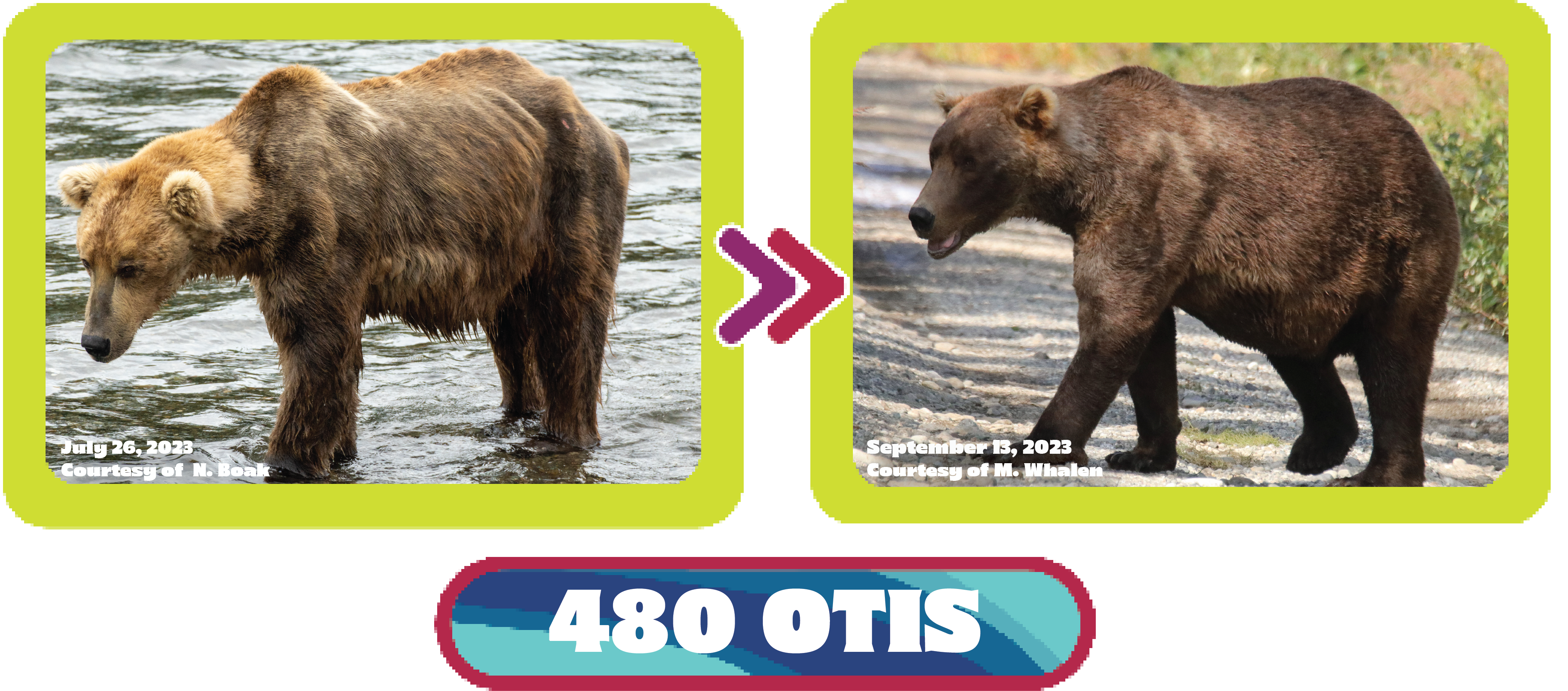
480 Otis’ weight transformation during the summer of 2023. Credit: N. Boak and M. Whalen via Explore.org.
It’s underdogs like Otis who are “scrappy and successful” that usually captivate bear-lovers, and ones that staff often consider for their brackets.
Bear Gathering At Katmai’s Brooks Falls
At Katmai National Park and Preservation, bears typically gather at Brooks Falls, something that is quite uncommon. According to the National Park Service as of August 2023, as many as 50+ bears have been spotted hunting salmon at Brooks Falls at the same time throughout the summer. Such a large gathering of bears in one location is captivating to see, Matt says, as these “normally solitary animals come out and will tolerate each other because of how much food there is around them. We usually don’t see this in nature; they don’t like seeing each other and have large territories.”
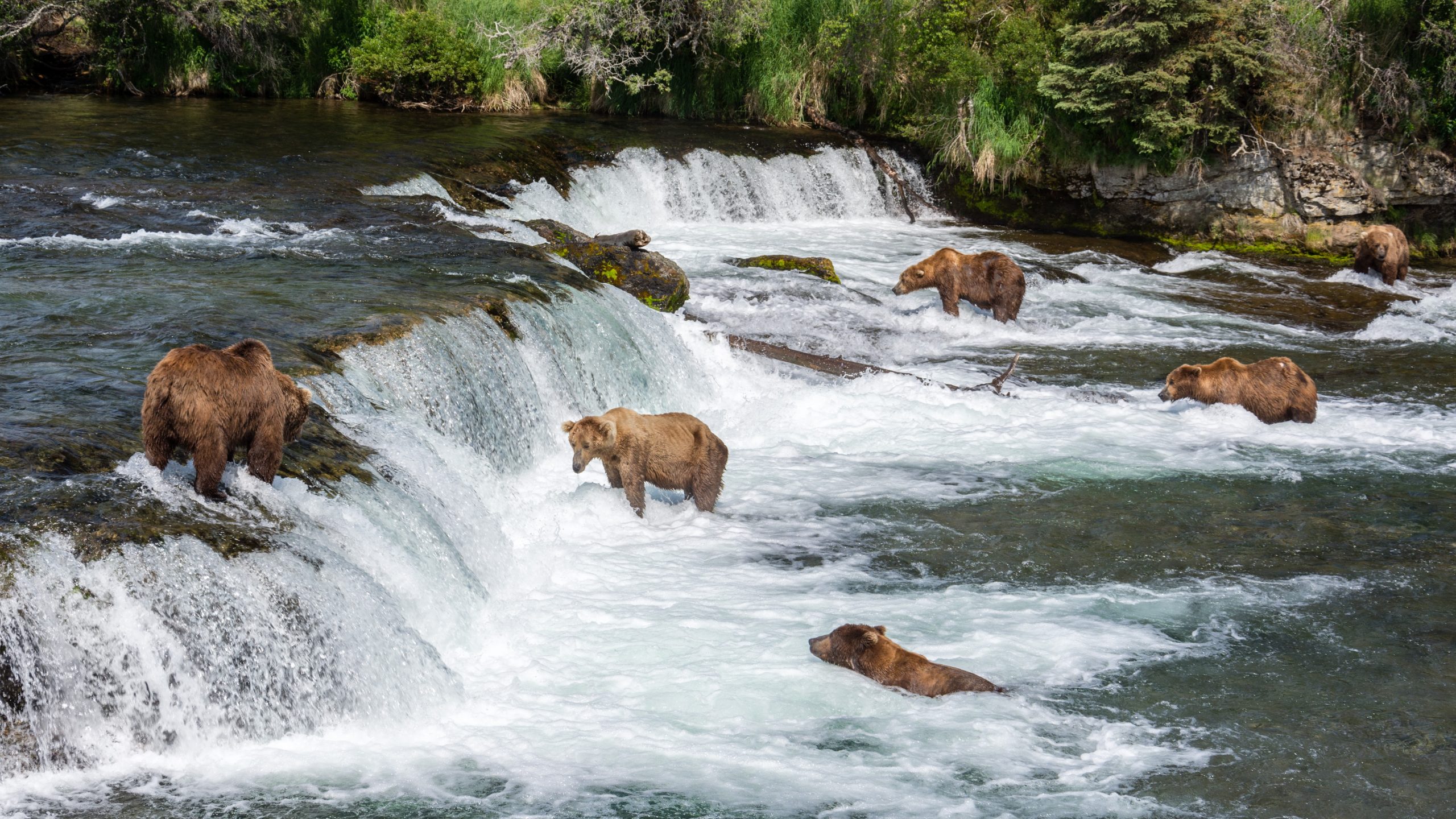
Bears gathering to hunt salmon at Brooks Falls in Katmai National Park and Preserve.
It helps that Alaska is unlike any other state. You can see three kinds of bears including polar, black, and brown bears all in the same state.
Katmai National Park and Preserve is an especially ideal location for bear viewing because it’s home to around 2,000 bears, many of which are brown bears, which are almost gone in the Lower 28. The park boasts a nearby lodge, a boardwalk, and an observation deck at Brooks Falls, offering up-close bear viewing opportunities while ensuring visitors’ safety. The Katmai National Park and Preserve boasts a size that is of Yellowstone and Yosemite National Parks combined, filled with active waters, volcanoes, and salmon runs, making it a must-see destination for all nature lovers.
Our guests visit this incredible National Park during a day of fly-in bear viewing on our Alaska: Glaciers & Grizzlies Adventure. The experience allows us to witness bears up close in their natural habitat, with expert guides leading the bear-viewing excursion to Brooks Falls or elsewhere, depending on where the best bear activity is at that time.
Bear Conservation in Katmai National Park & Preserve
While Fat Bear Week is an entertaining way to document and share the coastal brown bears’ preparation for hibernation, the competition encourages greater conversations about bear conservation and environmental sustainability.
An interesting result of this competition is park rangers’ pioneering use of ‘lidar’, otherwise known as ‘Light Detection and Ranging’ technology. Originally developed for mapping and cartography, park rangers now “adapt this technology for bears; instead of capturing and weighing bears, we can just point a laser scanner at them and be able to tell their density and estimate their approximate weights,” Matt explains. With this development from Fat Bear Week, park rangers can monitor the bears and aid in conservation safely and ethically.
Participants can also see the connection between sustainability and conservation firsthand as they witness how the bears rely on a flourishing ecosystem to survive.
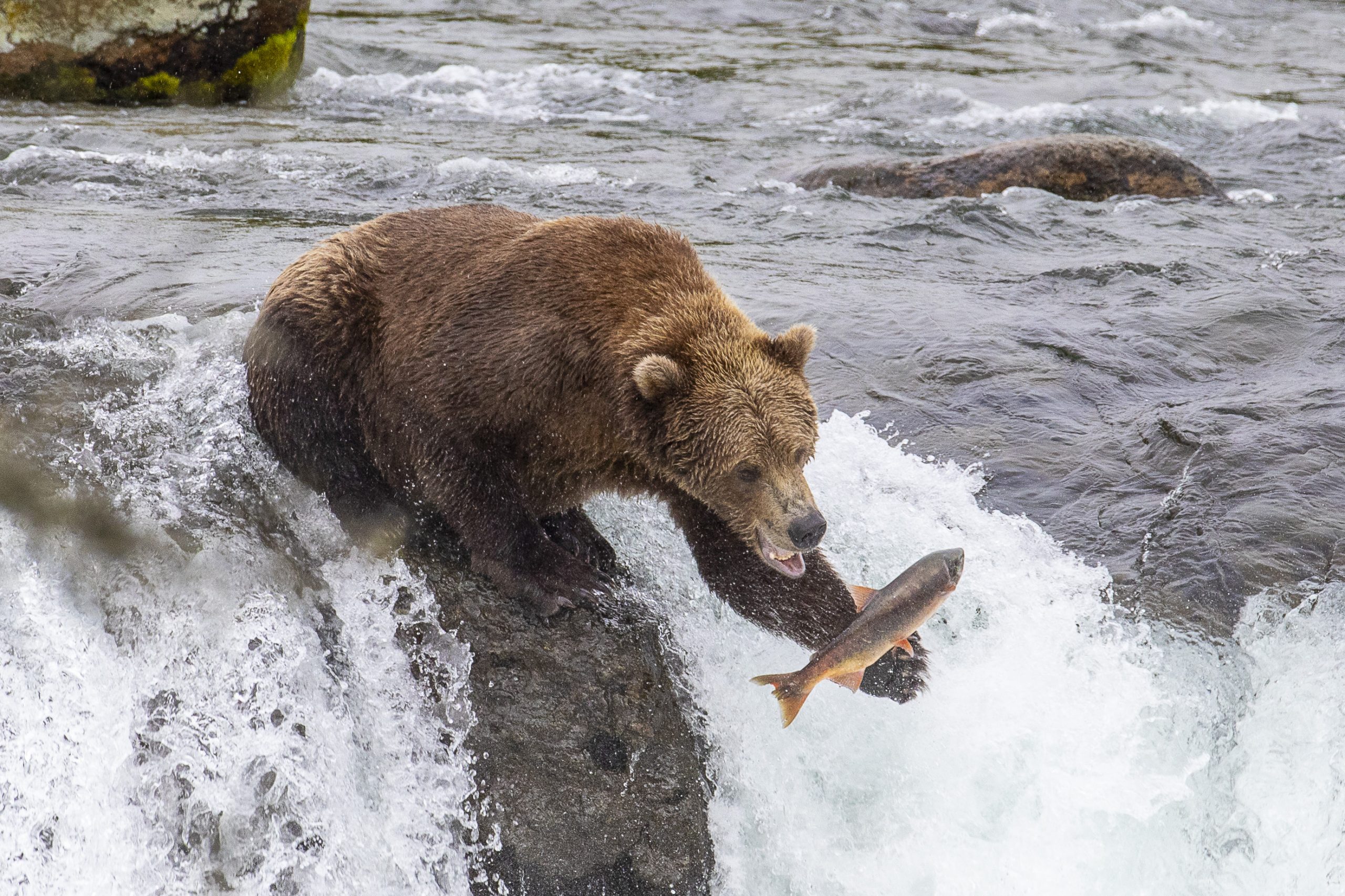
A bear reaching for its prey fish at Katmai National Park and Preserve.
“Fat Bear Week is a great example of a healthy and functioning ecosystem because the watersheds are protected in Katmai. We still have healthy, plentiful salmon runs because of this and so the bears gather here. People see this, recognize the connection and want to help preserve parks and bears,” Matt says.
Beyond rooting for a beloved bear throughout Fat Bear Week, people can take part in conservation from home. As Matt shares, “One of the things you can do is allow bears into your heart. Include them in the community that you live in and understand that your community supports them and their survival.” By understanding this connection, people can directly support the wildlife that surrounds them by practicing sustainable living and taking care of the environment around them.
“This is the main mission of the National Park Service which is conservation,” Matt adds.
How to Safely Travel in Bear Country
It is also important to travel safely through bears’ natural habitats to protect them and yourself. Matt Johnson, Interpretation and Education Program Manager and Public Information Officer at Katmai National Park and Preserve advises that the best practices include:
- Traveling in groups
- Sticking to the dedicated trail
- Carrying bear spray
- Storing food properly
- Making noise
To access more resources about bears and the park, participants can visit the Katmai branch of the National Park Service website as well as the competition’s partner websites including Katmai Conservancy and Explore.org.
How to Play the Fat Bear Week Bracket
To participate in this year’s Fat Bear Week competition, head to Explore.org. You can read more about each bear, watch the live video feeds of the bears, and review the tournament brackets before casting your vote on who will reign as this year’s fattest champion.
You can also join the fun by voting in Fat Bear Junior, the tournament bracket for the cubs of Katmai National Park & Preserve.

